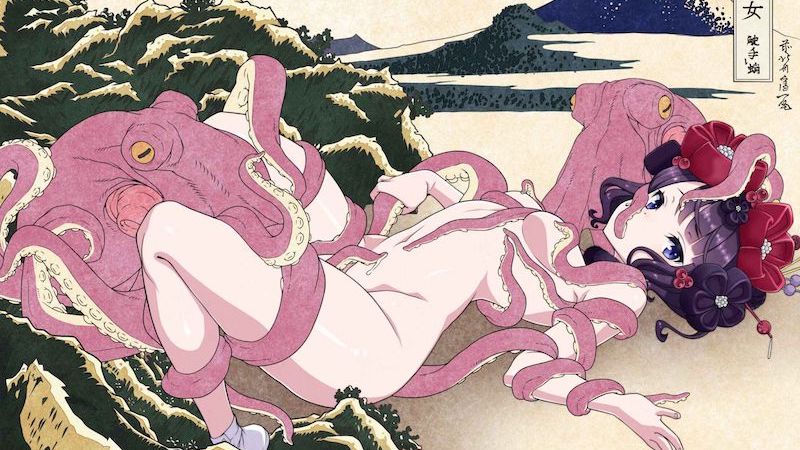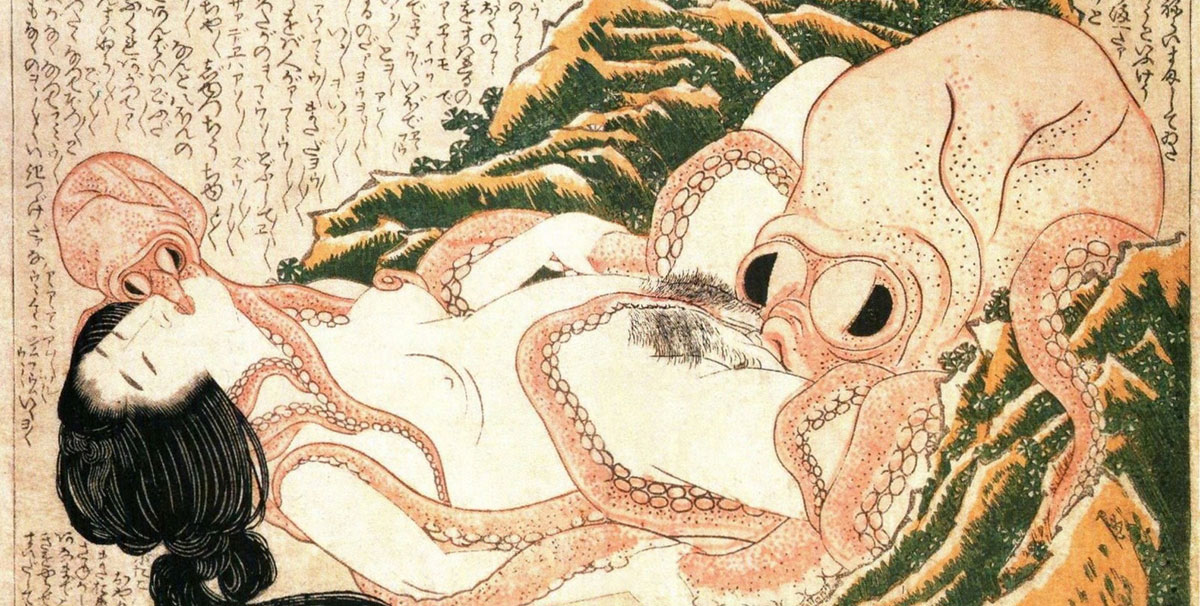Tentacle Manga – Japan’s victim/victimizer dynamic in comics
- 3 November 2022
- Posted by: Michael H Hallett
- Category: Arts , Patriarchy , Pornography ,

In May 2019 I published a blog titled The Alien inside us – the lower masculine victimizer. In it, I used Ridley Scott’s mandible and tentacle armed creature as a metaphor for patriarchy’s structural dynamic where everyone becomes both victim and victimizer. I recently learned Japan has an entire comic genre devoted to this: ‘tentacle manga’, a.k.a. octopus porn.
What is the victim/victimizer dynamic?
What do I mean by ‘patriarchy’s structural dynamic above? Here’s a recap:
“The rise of patriarchy created a new dynamic that became embedded in the human psyche: victimizer and victim. Ever since, we have bought into the basic notion that we can victimize those weaker than us while those who are more powerful than us can victimize us in any way they can get away with: physically, emotionally, sexually, financially.
Generally thought of as the dominion of men over women, patriarchy is more accurately the dominion of the (masculine) victimizer over the (feminine) victim.”
In Ancient Greece, the husbands of unfaithful women were permitted to insert spiked fish into the adulterer’s anus. This public humiliation downgraded the latter’s social status from masculine to feminine (i.e., receptive), a catastrophic fall.
“Both men and women can be victimizers. As well as victimizing women, men victimized other men violently, economically and at times sexually. Ruling class women victimized their servants and slaves, male and female alike, sometimes more cruelly than their men did.
Every civilization since the rise of patriarchy has victimized to the greatest extent that it could: Assyria, Rome, the Muslim Caliphate, Genghis Khan, the empires of Spain, Russia, Britain and Japan. All our laws and civil institutions have been enacted to contain and control this victimization.”
The Alien’s tentacle
Until now, I saw the Alien as the clearest artistic representation of the active side of this dynamic, what I termed ‘the lower masculine victimizer’:
“I use the word ‘lower’ because the masculine qualities of strength, intelligence and anger can all be expressed in a ‘higher’, protective manner. Here they are used to mitigate lack at the expense of others—and to express primal pain.
The Alien is the perfect embodiment of the lower masculine victimizer. It wants what it wants and will commit any brutality to achieve its ends. You can’t kill the fucker, it has acid in its veins, it drools and doesn’t clean up after itself.”
The penis—an image forbidden by society—physically embodies the lower masculine victimizer. What do you do when you can’t portray a penis? You use a tentacle. It’s what Ridley Scott did in the original Alien film (1979):
“There’s a telling scene—the subject of argument with film censors—where the Alien kills a female crewmember by thrusting its tail spike up between her legs.”
Origins of tentacle manga
In the following decade, the tentacle-as-penis trope migrated into Japanese manga (graphic novels). It began with Toshio Maeda’s 1986 manga Urotsukidōji, ‘Legend of the Overfiend’, that did not include any tentacle sex.
The following year Hideki Takayama adapted the novel into an animated series, adding “so much violent, terrifying tentacular sex” that Maeda became known as the ‘tentacle master’.
Tentacle manga is a brilliant visual representation of Japan’s highly stressed society where work-life balance is a little known or applied concept. Instead ‘salaryman’, a white-collar career man, works stupendous hours in the corporate sector. In addition to his regular working hours, salaryman is expected to put in overtime at his own expense as well as attending night-time corporate leisure events.
On Anthony Bourdain’s Parts Unknown Tokyo episode, Toshio Maeda comments that, “You need to, you know—letting off steam—so probably the manga is the one way to do that.”
“Letting off steam”
What happens when salaryman lets off steam? He reads tentacle manga on the subway home. Reading graphic novels of octopuses raping young women is apparently an accepted public activity is Japan.
It’s easy to see tentacle manga as an expression of male sexual desires denied by an overbearing work life and culturally conservative society. But that misses the point.
The victim/victimizer dynamic is a cycle. Everyone occupies both roles.
Salaryman, taking the subway to his suburban Tokyo home, isn’t just looking at a substitute metaphor for his thwarted penetrative desires. The octopus is the corporation, raping him day after day, getting what it wants, sucking him dry—while he gets nothing.
Salaryman is that guy in Ancient Greece with a spiky fish in his anus. In the feminine, receptive position, publicly humiliated, derided, ridiculed. In his anger, his powerlessness against the octopus, he turns his rage on his own victims—women. He humiliates them by publicly viewing lurid images of tentacle penetration while they stand powerlessly by. The cycle continues.
The really weird thing about Japanese tentacle sex is that it’s not a recent phenomenon. It’s over two centuries old. In 1814, Katsushika Hokusai carved a woodcut entitled The dream of the fisherman’s wife depicting exactly that. Flip the image and it’s virtually indistinguishable from the one above.

Never stop at the surface with a porn image. As I wrote in The 4 layers of a porn image, “The layers of a porn image are among the most intelligent tools we have for deconstructing the unconscious and bringing it to light.”
Tentacle manga is no exception.

